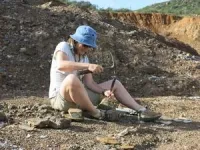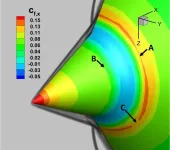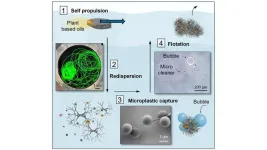(Press-News.org) A new species of fossil from 444 million years ago that has perfectly preserved insides has been affectionately named ‘Sue’ after its discoverer’s mum.
The result of 25 years of work by a University of Leicester palaeontologist and published in the journal Palaeontology, the study details a new species of multisegmented fossil and is now officially named as Keurbos susanae.
Lead author Professor Sarah Gabbott from the School of Geography, Geology and the Environment said: “‘Sue’ is an inside-out, legless, headless wonder. Remarkably her insides are a mineralised time-capsule: muscles, sinews, tendons and even guts all preserved in unimaginable detail. And yet her durable carapace, legs and head are missing – lost to decay over 440 million years ago.
“We are now sure she was a primitive marine arthropod but her precise evolutionary relationships remain frustratingly elusive.”
Today about 85% of animals on Earth are arthropods, and they include shrimps, lobsters, spiders, mites, millipedes and centipedes.
They have an excellent fossil record stretching back over 500 million years but usually their fossil remains are of their external features, whereas ‘Sue’ is the complete opposite because it is her insides that are fossilized.
The fossil was found in the Soom Shale, a band of silts and clays at a location 250 miles north of Cape Town in South Africa. These strata were laid down on the seafloor over 440 million years ago at a time when a devastating glaciation had wiped out about 85% of Earth’s species – one of the big five ‘mass extinctions’. It seems that the marine basin in which ‘Sue’ swam was somehow protected from the worst of the freezing conditions and a fascinating community of animals, including ‘Sue’, took refuge there.
The conditions in the sediments where Sue came to rest were toxic in the extreme. There was no oxygen but worse than that there was deadly (and stinking) hydrogen sulphide dissolved in the water. The researchers suspect that a strange chemical alchemy was at work in creating the fossil and its unusual inside-out preservation.
But there is a downside, because the unique preservation of ‘Sue’ makes it difficult to compare her to other fossils of the era and so it remains a mystery how she fits into the evolutionary tree of life.
The small roadside quarry where Professor Gabbott found the fossils 25 years ago at the start of her academic career has all but disappeared and so other specimens are unlikely to be found. The fossil was incredibly difficult to interpret and Professor Gabbott held out hope of finding another specimen with its head or legs intact.
Professor Gabbott adds: “This has been an ultramarathon of a research effort. In a large part because this fossil is just so beautifully preserved there’s so much anatomy there that needs interpreting. Layer upon on layer of exquisite detail and complexity. I’d always hoped to find new specimens but it seems after 25 years of searching this fossil is vanishingly rare – so I can hang on no longer. Especially as recently my mum said to me ‘Sarah if you are going to name this fossil after me, you’d better get on and do it before I am in the ground and fossilized myself’.
“I tell my mum in jest that I named the fossil Sue after her because she is a well-preserved specimen! But, in truth, I named her Sue because my mum always said I should follow a career that makes me happy – whatever that may be. For me that is digging rocks, finding fossils and then trying to figure out how they lived what they tell us about ancient life and evolution on Earth.”
END
New species revealed after 25 years of study on ‘inside out’ fossil – and named after discoverer’s mum
Study from University of Leicester describes a new species of fossil that is 444 million years-old with soft insides perfectly preserved
2025-03-27
ELSE PRESS RELEASES FROM THIS DATE:
THE LANCET HIV: Proposed cuts to foreign aid could result in millions of HIV deaths and soaring rates of global HIV infections, new modelling study estimates
2025-03-27
New modelling analysis suggests that proposed funding cuts by major donor countries to foreign aid could undo decades of progress made to end HIV/AIDS as a public health threat and new infections and deaths could surge back to levels not seen since the early 2000s.
The study estimates there could be between 4.4 million to 10.8 million additional new HIV infections by 2030 in low-and-middle income countries (LMICs) and between 770,000 to 2.9 million HIV-related deaths in children and adults by 2030.
The greatest impact from potential funding ...
Study reveals association between dietary sodium consumption and both general and abdominal obesity
2025-03-26
New research to be presented at this year’s European Congress on Obesity (ECO 2025, Malaga, Spain, 11-14 May) shows an association between the amount of sodium consumed in the diet and the risk of both general and abdominal obesity. The study is by Annika Santalahti, Finnish Institute for Health and Welfare, Helsinki, Finland, and colleagues.
General obesity is a person’s obesity status as measured by their body mass index (BMI), with WHO international guidelines stating a BMI of 30 kg/m2 or more means a person is living with obesity. Abdominal obesity is where fat accumulates around the abdomen and internal organs there, leading ...
Study finds knowledge of genetics and genomic medicine crucial for mental health providers to deliver informed, personalized care
2025-03-26
San Diego—March 26, 2025– In a manuscript published today in the American Journal of Psychiatry titled Psychiatric Genetics in Clinical Practice: Essential Knowledge for Mental Health Professionals, authors provide updated guidelines on what mental health professionals should know about the latest advances in genetics and how genetics can inform clinical psychiatric practice.
Key findings highlight the importance of understanding the genetic architecture of psychiatric disorders, the potential applications of genetic information in risk assessment, diagnosis, treatment selection, and patient education, ...
Hypersonic simulation in 3D exposes new disturbances
2025-03-26
At hypersonic speeds, complexities occur when the gases interact with the surface of the vehicle such as boundary layers and shock waves. Researchers in the Department of Aerospace Engineering in The Grainger College of Engineering, University of Illinois Urbana-Champaign were able to observe new disturbances in simulations conducted for the first time in 3D.
Fully 3D simulations require a great deal of processing power, making the work expensive to compute. Two things made it possible for Deborah Levin and her Ph.D. student Irmak Taylan Karpuzcu to conduct the research: Time on Frontera, the National Science Foundation-funded leadership-class computer system at the Texas ...
Your neighborhood may affect your risk of dementia
2025-03-26
EMBARGOED FOR RELEASE UNTIL 4:00 P.M. ET, WEDNESDAY, MARCH 26, 2025
MINNEAPOLIS — People living in more disadvantaged neighborhoods may be more likely to develop dementia than people living in neighborhoods with fewer disadvantages, according to a study published on March 26, 2025, online in Neurology®, the medical journal of the American Academy of Neurology. The study does not prove that neighborhood factors cause dementia; it only shows an association.
Neighborhood status was determined by factors such as income, employment, education and disability.
“Our findings show that the community in which you live influences your risk of developing dementia,” ...
Early signs of heart problems linked to smaller brain volumes
2025-03-26
EMBARGOED FOR RELEASE UNTIL 4:00 P.M. ET, WEDNESDAY, MARCH 26, 2025
MINNEAPOLIS — People who have early signs of heart problems may also have changes in brain health that can be early signs of dementia, such as loss of brain volume, according to a meta-analysis published on March 26, 2025, online in Neurology®, the medical journal of the American Academy of Neurology. The meta-analysis does not prove that early heart problems cause loss of brain cells; it only shows an association.
“This review shows that better ...
Research finds potential “molecular mimics” behind COVID-induced autoimmune disease
2025-03-26
COVID infection has been linked to higher risk of autoimmune disorders, including rheumatoid arthritis and type 1 diabetes. But why the virus might cause the body’s immune system to go haywire remains unknown, making it difficult to develop therapies to avoid autoimmunity. One hypothesis is that viral “molecular mimics” that resemble the body’s own proteins trigger an immune response against the virus—and healthy tissues get caught in the crossfire.
Now, with advanced data analysis and machine learning, scientists have identified a set of COVID-derived ...
Pennington Biomedical researchers identify neurons in brain that regulate energy levels and body temperature
2025-03-26
FOR IMMEDIATE RELEASE
March 26, 2025
BATON ROUGE – Scientists at Pennington Biomedical Research Center have gained greater clarity in the brain regions and neurons that control metabolism, body temperature and energy use. Featured in the February edition of the journal Metabolism, Dr. Heike Münzberg-Gruening and a team of researchers discovered which chemicals influence the signals that control how much energy the body uses. In “Leptin Receptor Neurons in the dorsomedial hypothalamus require distinct neuronal subsets for thermogenesis and weight loss,” researchers laid out the pathways, chemicals, neurons ...
Cleaning microplastics
2025-03-26
In a new paper, researchers at North Carolina State University show proof of concept for a system that, in a single cycle, actively removes microplastics from water.
The findings, described in the journal Advanced Functional Materials, hold the potential for advances in cleansing oceans and other bodies of water of tiny plastics that may harm human health and the environment.
“The idea behind this work is: Can we make the cleaning materials in the form of soft particles that self-disperse in water, capture microplastics as they sink, and then return to the surface with the captured microplastic contaminants?” said Orlin Velev, the S. Frank and Doris Culberson Distinguished ...
MD Anderson names Jeffrey E. Lee, M.D., Chief Medical Executive
2025-03-26
HOUSTON ― The University of Texas MD Anderson Cancer Center today announced that Jeffrey E. Lee, M.D., an internationally regarded leader in the field of oncology, has been appointed chief medical executive (CME) effective April 1.
Prior to his appointment, Lee served as CME ad interim, demonstrating strength as a leader committed to advancing the institution’s efforts in research, patient care, prevention and education. Assuming the role of CME is the culmination of Lee’s 34-year tenure at the institution, where he has made substantial contributions in the field ...
LAST 30 PRESS RELEASES:
Tracing the quick synthesis of an industrially important catalyst
New software sheds light on cancer’s hidden genetic networks
UT Health San Antonio awarded $3 million in CPRIT grants to bolster cancer research and prevention efforts in South Texas
Third symposium spotlights global challenge of new contaminants in China’s fight against pollution
From straw to soil harmony: International team reveals how biochar supercharges carbon-smart farming
Myeloma: How AI is redrawing the map of cancer care
Manhattan E. Charurat, Ph.D., MHS invested as the Homer and Martha Gudelsky Distinguished Professor in Medicine at the University of Maryland School of Medicine
Insilico Medicine’s Pharma.AI Q4 Winter Launch Recap: Revolutionizing drug discovery with cutting-edge AI innovations, accelerating the path to pharmaceutical superintelligence
Nanoplastics have diet-dependent impacts on digestive system health
Brain neuron death occurs throughout life and increases with age, a natural human protein drug may halt neuron death in Alzheimer’s disease
SPIE and CLP announce the recipients of the 2025 Advanced Photonics Young Innovator Award
Lessons from the Caldor Fire’s Christmas Valley ‘Miracle’
Ant societies rose by trading individual protection for collective power
Research reveals how ancient viral DNA shapes early embryonic development
A molecular gatekeeper that controls protein synthesis
New ‘cloaking device’ concept to shield sensitive tech from magnetic fields
Researchers show impact of mountain building and climate change on alpine biodiversity
Study models the transition from Neanderthals to modern humans in Europe
University of Phoenix College of Doctoral Studies releases white paper on AI-driven skilling to reduce burnout and restore worker autonomy
AIs fail at the game of visual “telephone”
The levers for a sustainable food system
Potential changes in US homelessness by ending federal support for housing first programs
Vulnerability of large language models to prompt injection when providing medical advice
Researchers develop new system for high-energy-density, long-life, multi-electron transfer bromine-based flow batteries
Ending federal support for housing first programs could increase U.S. homelessness by 5% in one year, new JAMA study finds
New research uncovers molecular ‘safety switch’ shielding cancers from immune attack
Bacteria resisting viral infection can still sink carbon to ocean floor
Younger biological age may increase depression risk in older women during COVID-19
Bharat Innovates 2026 National Basecamp Showcases India’s Most Promising Deep-Tech Ventures
Here’s what determines whether your income level rises or falls
[Press-News.org] New species revealed after 25 years of study on ‘inside out’ fossil – and named after discoverer’s mumStudy from University of Leicester describes a new species of fossil that is 444 million years-old with soft insides perfectly preserved





